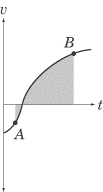Lesson: Chapter - 5
Explanations
Explanation of the practice questions.
1. C
Displacement is a vector quantity that measures the distance between the
starting point and ending point, not taking the actual path traveled into
account. At the end of four laps, the athlete will be back at the starting line
for the track, so the athlete’s total displacement will be zero.
2. D
Statement I refers to distance, not displacement, since the five-mile distance
is along a winding road and does not describe a straight-line path.
Both statements II and III, however, contain a reference to displacement. The
altitude of a town is a measure of the straight-line distance between the town
and sea level. “As the crow flies” is a common way of saying “in a straight-line
path.” Neither statement II nor statement III describes a certain route between
the two points in question: they simply describe how far apart those two points
are.
3. A
Average velocity is a measure of total displacement divided by total time. Total
displacement is the distance separating the starting point and the finishing
point. Since the car both starts and finishes at point
A, its total displacement is zero,
so its average velocity is also zero.
4. B
Average speed is a measure of total distance traveled divided by the total time
of the trip. Solving this problem calls for a single calculation:

5. E
The force of air resistance against a ball increases as the ball accelerates. At
a certain point, the force of air resistance will be equal to the force of
gravity, and the net force acting on the ball will be zero. At this point, its
velocity will remain constant. This velocity is known as an object’s “terminal
velocity,” and it explains why, in real life, many falling objects don’t
continue accelerating all the way to the ground.
6. C
Acceleration is a measure of the change in velocity over time. The car’s change
in velocity is 40 – 20 = 20 m/s. Since this
change in velocity takes place over 4
seconds, the car’s acceleration is

7. C
Point A is below the t-axis, which means that the velocity is
negative. Since velocity is the change in displacement over time, we can
conclude that if the velocity is negative, then the displacement is decreasing.
Acceleration is given by the slope of the graph. Since the line at point A
has a positive slope, we know that the acceleration is increasing.
8. C
Acceleration is given by the slope of the line. As we can see, the slope is
greater at point A than at point B, so the acceleration is less at
point B.
The change in displacement is given by the area between the graph and the t-axis:

As we can see, between points A and B, a great deal more of the
graph is above the t-axis than below it. This means that, overall,
displacement is positive between these two points.
9. D
We know the total distance the sprinter covers, and we know the total time.
However, since the acceleration isn’t uniform, we can’t calculate the velocity
quite so simply. Rather, we need two equations, one for the first
50 meters of the race, and another for the
second 50 meters. In the first 50 meters,
the sprinter accelerates from an initial velocity of
v0 = 0 to a final vector of v in an
amount of time,
t1.
We can express this relationship using the kinematic equation that leaves out
velocity, and then solve for t:

In the last 50 meters of the race, the sprinter runs with a constant velocity of v,
covering a distance of x = 50 m in a time t2 . t2 Solving for , we find:

We know that the total time of the race, t1 + t2 = 10 s.
With this in mind, we can add the two sprint times together and solve for v:

10. A
Average velocity is given by the total displacement divided by the total time
elapsed. The displacement is not simply 30 + 40 =
70 m, however, since the woman doesn’t run in a straight-line path. The
40 m north and the
30 m east are at right angles to one
another, so we can use the Pythagorean Theorem to determine that the total
displacement is in fact 50 m. Her
displacement is 50 m over a total time of
10 s, so her average velocity is
5.0 m/s.
Back
Next
Next to display next topic in the chapter.
Practice Questions
Video Lessons and 10 Fully Explained Grand Tests
Large number of solved practice MCQ with explanations. Video Lessons and 10 Fully explained Grand/Full Tests.